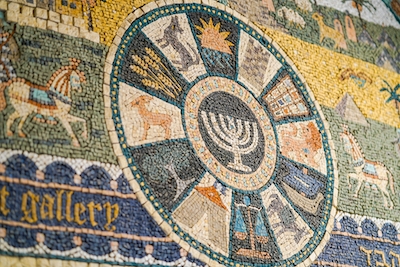The conclusion of the Passover seder features a folkloric song called Chad Gadya, in which a father purchases a baby goat for two zuzim (small coins) only to see it eaten by a cat. In the next stanza the cat is bitten by a dog, and in the next the dog is hit by a stick, which is then burned by a fire, that is then extinguished by water, which is then drunk by an ox, which is then killed by a slaughterer, who is then felled by the Angel of Death. In the final stanza, the escalating chain of death and destruction is finally brought to an end when God eradicates the bringer of death himself.
The song is a Passover classic — but its origins are unclear, its status as the seder capstone a mystery, and its meaning subject to a wide range of interpretation.
Authorship of Chad Gadya is unknown. The song is believed to have entered the Passover liturgy some time in the 16th century, long after most of the Haggadah was already fixed. A famous Haggadah published in Prague in 1526 does not contain the song, while a 1590 edition of it does. There is a tradition that it was known to, and perhaps authored by, Rabbi Eleazar of Worms, a German kabbalist born in the 12th century. It has also been suggested that the song is inspired by a midrash in which Abraham debates the biblical king Nimrod, who tries to persuade him to worship fire. Abraham counters that water extinguishes fire, so Nimrod suggests worshipping water. Abraham then counters that the clouds contain water, so Nimrod suggests worshipping the clouds. And so on.
All these possibilities would seem to fly in the face of a widely asserted claim that the song is a Jewish version of a 17th-century German folk song, “Der Bauer schickt den Jockel aus” (“The Farmer Sends Out Jockel”), about a lazy boy who is sent to cut oats. When Jockel refuses, the farmer sends out a farmhand to fetch him, but the farmhand refuses too, so a dog is sent, and then a club to hit the dog, and so forth. There are also several analogues to the song in other cultures, including the French “Biquette ne Veut pas Sortir du Chou” (“The Nanny-goat Won’t Get Out of the Cabbage”).

Help us keep Jewish knowledge accessible to millions of people around the world.
Your donation to My Jewish Learning fuels endless journeys of Jewish discovery. With your help, My Jewish Learning can continue to provide nonstop opportunities for learning, connection and growth.
If its origins are cloudy, its symbolism is even more so. It’s often said that each character in the song symbolizes a nation that persecuted the Jewish people. In this telling, the Israelites are represented by the kid, acquired for two zuzim (representing the two tablets of the covenant), and was then oppressed by a succession of ever more powerful empires until its ultimate redemption by God. Many other interpretations accept this basic framework while adopting different associations for the various characters.
Among the most famous of these was offered by the Vilna Gaon, the 17th-century Lithuanian scholar, who posited that the kid refers to the birthright that Jacob bought from Esau for bread and lentils (two zuzim), and thus symbolizes the special relationship between Israel and God. That blessing then passed to Joseph, who was the object of envy from his brothers, represented by the cat. The dog represents Pharaoh, who enslaved Jacob’s descendants, and the stick represents Moses, who redeemed them (and, famously, carried a rod). The allegory continues throughout Jewish history, culminating in the ultimate redemption and banishment of death that only God can bring.
Others have suggested that the song represents the journey of a soul through the world, with each of the characters representing an obstacle on the soul’s path to refinement. Or that it’s an indictment of cycles of violence and revenge that escalate until only God is left to restore order and keep the peace. Or that it’s a statement of faith, that even in the face of seemingly endless violence and killing there is a divine justice that will eventually prevail.
Common to all these understandings is a sense of the turbulence, violence and disorder that is endemic to human existence. At the conclusion of a long evening spent retelling the story of the Exodus and celebrating freedom, Chad Yadya seems to present an image of the world in which the strong devour the weak and danger lurks around every corner. Yet at the end of this long progression is God, the one who vanquishes death and brings order to the world.
“The song itself, disarming in its simplicity, teaches the great truth of Jewish hope: that though many nations (symbolized by the cat, the dog, and so on) attacked Israel (the “goat”), each in turn has vanished into oblivion,” writes Rabbi Jonathan Sacks. “At the end of days God will vanquish the angel of death and inaugurate a world of life and peace, the two great Jewish loves.”



